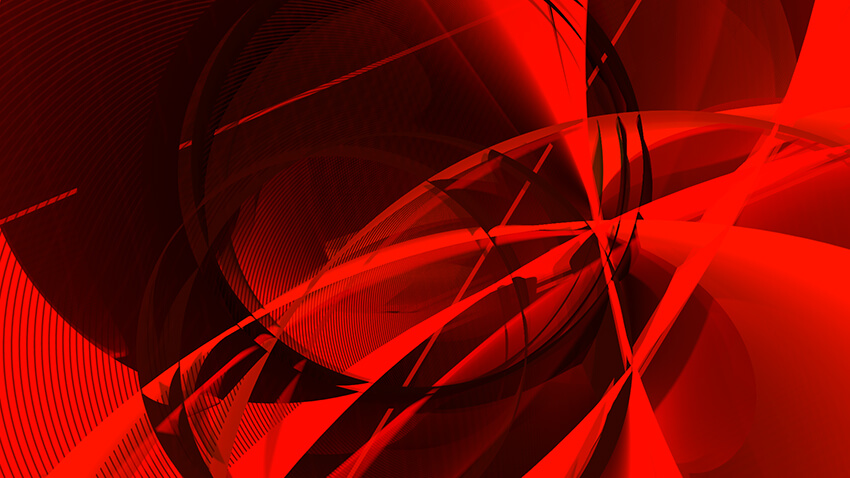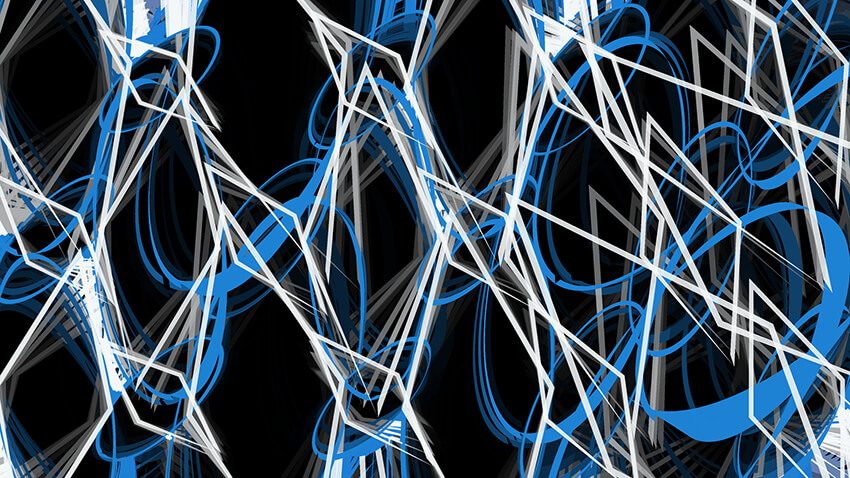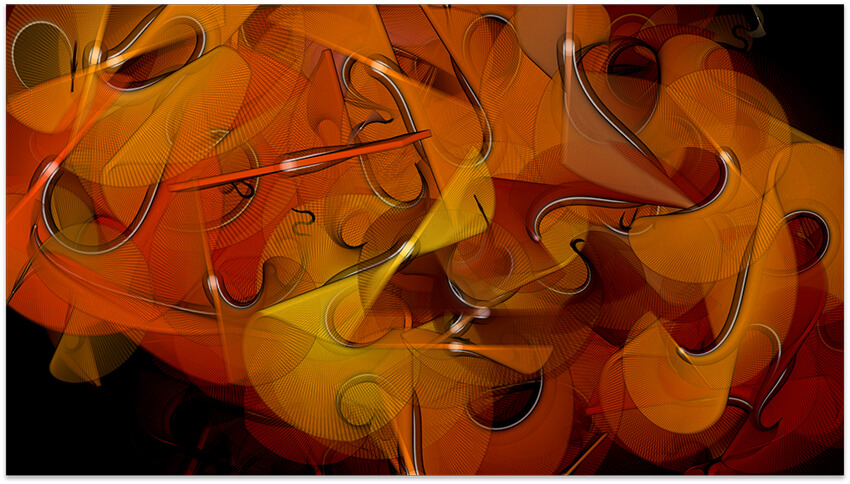Interview by Laura Netz

Austrian artist LIA is considered one of the pioneers of digital art and has been producing works since 1995. She is one of the very few women pioneers in software and net art. Her practice spans across video, performance, software, installation, sculpture, projections, and digital applications.
The artist’s primary working material is code, and the process of work consists of translating a concept into a formal written structure to create a “machine” that generates real-time multimedia outputs. The relationship between machine and artist can be viewed as a conversation. LIA’s works are examples of the aesthetics of digital images and algorithms, characterised by a minimalist quality and by an affinity with conceptual art.
LIA creations in the net art context are those such as Re-move, a net artwork developed through 1999 – 2003, which allows users to manipulate a series of generative audiovisual compositions based on organic forms in the fin-de-siècle Viennese abstraction. The work is newly restored as part of the Net Art Anthology at Rhizome platform. Furthermore, LIA has been very active in the past as a live visuals artist with a 17-year-long running collaboration with the @c duo, but also performing live visuals with musicians like Vitor Joaquim (since 2005) and Emi Maeda (since 2006); also, with the orchestra of Linz, at the Brucknerhaus, and the orchestra of Barcelona, at L’Auditori during the Sónar festival.
On the 3rd of July, LIA is presenting Nine Suns on Sedition, a new piece available as a limited edition video of a generative work which references the nature of the universe. It is also connected to her previous work, Three Suns, which is a generative application from 2012. And from the 15th of June until the 29th of September, the interactive work Tentasho is shown at the Eden Project in Cornwall, England, and LIA also has a cooperation with the American company Standardvision which is showing some of her videos on large projection screens regularly throughout the world.
With LIA’s work stemming from the concept of fluidity – as opposed to the formality of the written code that requires engineered precision- the orchestration of morphogenetic processes becomes the poetry of the code, halfway between the organic and the synthetic, alien structures that pervade on an infinite flow of ecstatic beauty.


LIA is considered one of the pioneers of digital art and has been producing works since 1995. How do you find the role of being a woman in this scene? Do you think a feminist approach can improve the theory and practice of digital art?
This is a difficult question, and I think my idea about it has changed over the years. I somehow always wanted to ignore the fact that men and women are treated differently in society in general, but today I see that if I just try to ignore it, nothing will change either.
I do not like not being taken seriously because I am a woman, but at the same time, I also don’t like being invited to something just because I am a woman (and not because my work is good). It’s quite tricky finding a place (scene) where I feel that I actually belong to.
I think it is time for a more feminist approach in all possible fields, not only in the field of digital arts. What we consider today as the “norm” (in all fields) is what we are used to because it was established long ago. This does not necessarily mean that it is “normal” at all; it also means it can be changed at any point.
Your work using creative code becomes a generative work in real-time, introducing the concept of “fluid” as opposed to the formality of the written code that requires engineered precision. Can you give some examples of this?
I started as an autodidact, so at the beginning, I had no idea about how to write “clean” code. This led to a variety of interesting results that I had not planned upfront. After more than two decades of programming, I now know how to write code properly, but I still like to keep the process of programming open to all sorts of possible errors, being able to go into different directions from any point onward.
That means I am not planning every step ahead but rather “going with the flow”. The artworks themselves are constantly changing, either because they are of generative nature or because someone might be interacting with them. There is no start and no end. They evolve over time over and over again.
Re-move, the net.art work for users’ interaction has been hosted at the Rhizome net.art anthology. What is the actual context of net.art? Is it net.art destined to be preserved in media archaeology labs threatened by technology obsolescence?
I have to say that I am really very happy that Rhizome took on the challenge of making old works on the net.art accessible again. I don’t really see my duty as an artist to constantly keep all my work up to date. After so many years of intense output, I would be just busy archiving and updating instead of creating new work.
In my opinion, the “real” experience of net.art is gone by now, by which I mean the way of experiencing it alone at home, with a 56k modem connection, on a 640×480 pixel monitor with 256 colours and a single mouse button, connected to an Internet without constant advertisements. Rhizome has also done a really great job by also collecting old quotes and screenshots and explaining the time all this net.art was embedded in.
LIA has been playing live visuals since the early 2000s. Can you tell us about this experience? How is Live AV performance positioned nowadays in contemporary culture? How is its impact on the museum culture and music scene transforming how audiences experience art?
I went to a high school which specialised in music education, and I also played several instruments myself, so music was always a very important part of my work. I started doing live visuals for live performances for the Portuguese electronic music duo @c . We worked very closely together – I could tell them what kind of sounds I needed for my visuals set to work best, and by playing certain sounds live, @c would also partly be interacting with my visuals.
I have worked with a few more musicians since then, and also for some orchestras or classical music events, but in any case, it has always been important to me that I would know the music upfront (at least the style and the planned output and structure, in case it was played live) so that I could prepare the visuals accordingly.
I think there are basically two kinds of live visuals: one type where the visual artist prepares something specifically for a special kind of music, and another type, where the music and visuals combination is arbitrary, like in a club situation. I also think that the fact that projectors got more and more affordable for everyone got more people to think about, including live visualisations in general, like in theatre plays or dance performances.
Considering your experience as a digital artist in Sedition, do you think it is a bridge platform between New Media Art (NMA) / Mainstream Contemporary Art (MCA)? How do you see both interdependencies?
I see the Sedition model (and other online galleries) as an example of the gallery of the future for distributing digital art. It does not really need a physical space, as it does not have physical objects. Digital art is still under-represented in the regular art market: if you go to an established art fair, there is almost no digital art to be seen.
Already 20 years ago, the only question by the Centre Pompidou representative at a panel discussion was, “how do we preserve digital art?”. I think Rhizome.org have found some good answers, but the regular art market still seems to hesitate a lot to deal with digital art. The recently sold portrait at Christie’s, which was generated using the help of AI algorithms (it was not made by an AI!), showed that even being a piece of digital art (or software art), there was little acceptance and it was sold as a ready-made canvas painting.
Your Fluctus piece has recently been exhibited at Dong Gallery, Taipei (Taiwan), on a public display and curated by Filip Visnjic. Can you tell us more about the creative process, from ideation to execution and production?
The inspiration for Fluctus came from an old Japanese wave design book drawn by artist Mori Yuzan (1903). There is a free online version, and I found the drawings very intriguing. I thought I would like to see something like this, but moving and changing over time. So I started translating my visual impression of the book into code: in this case, the waves of the book are also literally translated into sine and cosine waves, used to programme the path of the moving elements.
Fluctus was edited specifically for the Dong Gallery screen. The work was adapted for an 11 meters long and 2.8 meters high screen and was on exhibition between February and March 2019. A version of the work is also available for sale as a digital edition via the Framed* online platform.
What is going to keep you busy in the coming months?
On the 3rd of July, I am launching a new work on Sedition. The piece called Nine Suns is a limited edition video of a generative work which references the nature of the universe. It’s also connected to one of my previous works, Three Suns, which is a generative application. A bit more than a year ago, I quit my teaching job to finally become a full-time artist (which, so far, has worked out just fine). This means that I have to be pickier about what kind of work I take on and about which projects I have to set aside a little bit.
Touring festivals do not really pay a lot, and it is not only exciting but can also be quite exhausting (like taking a plane 18 times a year), so I have basically stopped doing this with some exceptions. At the moment, I have not scheduled any exhibitions in fine art museums, but I never know a long time in advance when something like this will happen. As a creator, I am also experimenting with other forms of financing, including Patreon, a platform where I also engage with members who directly support my work.
What is your chief enemy of creativity?
At the moment, I would say reading all the bad daily news kills my creativity, it paralyses me to the point that I have to stop reading the newspapers for several days. Having to face climate catastrophe and watching right-wing politicians gaining a wide audience makes me feel helpless and sad and angry all at the same time.
You could not live without…
… oxygen and a planet with a surface temperature that supports human life.






